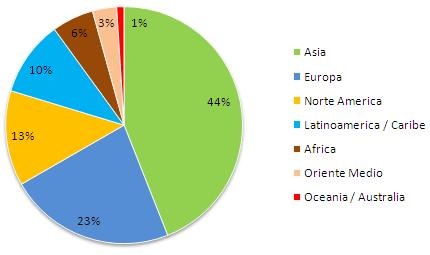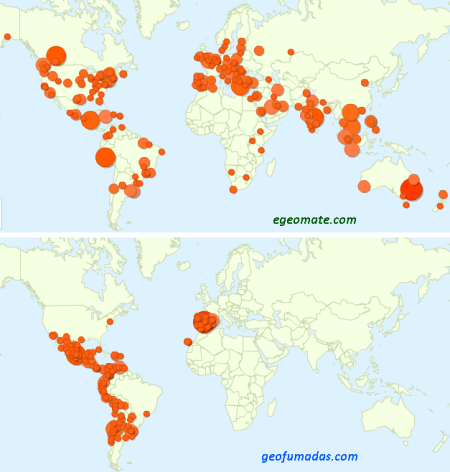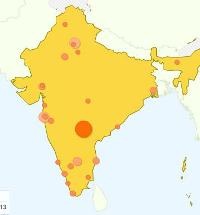Global Internet User Statistics
Recientemente Success Exporter has updated to the year 2011 world statistics regarding the penetration and use of the Internet worldwide. Perhaps one of the best sources to consult this type of information, not only at the continent level, but also at the country and language level.
I take this post to show some data, and to step trends in traffic behavior in Egeomate, less than a month after being released.
The following picture reflects the distribution of the 2 billion people with Internet access, a surprising 30% of the nearly 7 billion globally.
| Regions | Location | Users | % world |
| Asia | 3,879,740,877 | 922,329,554 | 44.00% |
| Europe | 816,426,346 | 476,213,935 | 22.70% |
| North America | 347,394,870 | 272,066,000 | 13.00% |
| Latin America and the Caribbean | 597,283,165 | 215,939,400 | 10.30% |
| Africa | 1,037,524,058 | 118,609,620 | 5.70% |
| Middle East | 216,258,843 | 68,553,666 | 3.30% |
| Oceania | 35,426,995 | 21,293,830 | 1.00% |
| TOTAL | 6,930,055,154 | 2,095,006,005 | 100.00% |

It is interesting to see how Latin America and the Caribbean are barely an 10%, however the Spanish language is the third most used worldwide, subtracting the Portuguese from Brazil and adding Spain the percentage is below 10.
Seeing what happens with EgeomateIt's interesting how different non-Hispanic traffic is compared to what I've been used to seeing in geofumadas. See how the English-speaking reader comes from all over the world, including countries like Spain, Peru, Mexico, Argentina and Chile; Unlike the Hispanic reader who is concentrated in the official language countries and some cities in the United States.

So writing in English is really writing for a global market; I have not yet managed to penetrate the AutoCAD niche so much, but it is interesting to see how Microstation, Manifold and Mobile Mapper move; topics for which there is little content on the Internet. The following table reflects the difference of the same map but at the country level;
(1-2) The United States stands out, whose behavior is similar to Spain in geofumables, with many visits from different cities. Although there is no Madrid or Barcelona that eat much of the traffic. In second place is Canada, which unlike the United States, there are very few cities with significant traffic.
(3-4) In third place is the United Kingdom and then India, understandable because it was an English colony. But also because in recent years it has had a tremendous technological boom and since it is the second most populated country in the world, it is an equivalent to Mexico geofumadas.
(5) Then there is Brazil, which, unlike what we might expect from similarity with Spanish and geographical proximity, the way to reach them is by English.
(6-10) The following countries, in order: Spain, Australia, Germany, the Philippines, and Vietnam. Curious group, all are in the group of the 20 countries with the most Internet users, with the exception of Australia, which is a special case because it is 80% of users from all over Oceania.
(11-15) These are 5 countries that I mention because as the trend stabilizes, they could take places from the previous group: Mexico, Malaysia, the Netherlands, Saudi Arabia and Turkey.

This is the case of the Hispanic countries, of which I had already spoken before. The red dots are the 10 with the most traffic, the others in yellow are the following 5. Look how Mexico, the United States and Spain are the only countries that have a coincidence between egeomate and geofumadas.
 The statistics are cold. But learning is valuable and more than exciting. It is curious to see in Woopra As a user of one of those orange dots in India, right from Hyderabad enters egeomate and wonders:
The statistics are cold. But learning is valuable and more than exciting. It is curious to see in Woopra As a user of one of those orange dots in India, right from Hyderabad enters egeomate and wonders:
वेश्या ... three days looking for how to do Contours with Civil 3D...
For a moment I had the impression that this friend is sitting on a sidewalk, with a turban and a flute to charm a cobra ... But in reality, he is a user like all of us, in an office using AutoCAD, wanting to switch to Mac and aspiring to this year learn MapGuide.
If you want to see more Internet statistics, I recommend Success Exporter.






